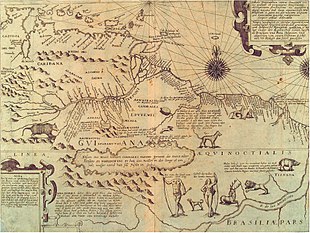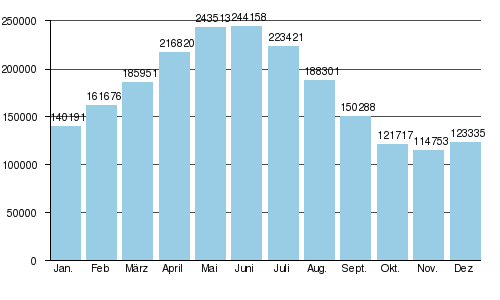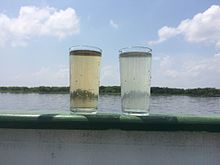Amazon River
![]()
This article is about the Amazon River, for other meanings see Amazon (disambiguation).
The Amazon River (also Portuguese Rio Amazonas, Spanish Río Amazonas, in Brazil above the confluence of the Rio Negro near Manaus Rio Solimões, formerly Rio Orellana) is a river in northern South America. About 300 km south of the equator, it crosses the Amazon basin, framed in the west by the Andes Mountains and dominated by tropical rainforest, eastward to the Atlantic Ocean. With an average water flow of 206,000 m³/s, the Amazon is by far the most water-rich river on earth and carries more water at its mouth than the next six smallest rivers combined and about 70 times more than the Rhine.
The river takes its name from the meeting of its two headwaters, the Marañón and the Ucayali, in Peru, but is interrupted by the Brazilian section above the city of Manaus, which is called the Rio Solimões. The river, which is usually several kilometres wide in Brazil, has a relatively balanced water flow, as the flood phases of the tributaries meet the main stream near the equator with a seasonal shift. Nevertheless, it can flood the adjacent forested alluvial areas (várzea) over a width of up to 60 km.
In two main arms it flows through the island world of the almost 200 km wide estuary, which is also connected to the Pará estuary by tidal waters and thus separates the large island of Marajó.
Name
Originally, the river had different names in different sections, which were used by the respective indigenous riparians. One such original name has survived to this day in the Portuguese name Solimões, which is officially used for the Brazilian upper reaches up to the confluence with the Rio Negro. The Spaniard Vicente Yáñez Pinzón, who was the first European explorer of the river, named it Río Santa María de la Mar Dulce, or Mar Dulce ("Freshwater Sea") for the freshwater found in the open sea off its mouth. Later, after 1502, the river was known to the Portuguese as Rio Grande ("Great River"), a name also used for several other rivers in Brazil. The Spanish began calling it Río Marañón in 1513, a name that is not entirely clear whether it comes from an indigenous language or derives from the Spanish word maraña, which means "tangle" and may be a reference to the confusing confusion of the many branching watercourses. This name was prevalent in Spanish-speaking geography for a long time and has survived in the name of the northern headwaters and the Peruvian province of the same name, Marañón, as well as in the name of the Brazilian state of Maranhão on the lower reaches. It is also possible that the name of the estuarine island Marajó derives from the same linguistic root.
The origin of the name Amazon is not fully understood. It is usually attributed to the fact that on the voyage of Francisco de Orellana (who set out from Ecuador in 1540 with the Gonzalo Pizarro expedition and reached what is now the Amazon River in January 1542 and was the first to cross it to the mouth of the Atlantic), the Spanish explorers saw Indian warrior women and therefore named the river after the legendary Amazons. The chronicler of the expedition, the Dominican Gaspar de Carvajal, describes in his travel diary the encounter, allegedly in June 1542, with "very fair-skinned and tall women, wearing their very long hair braided around their heads and very stoutly built." They fought fiercely and decisively "like leaders at the head of the Indians" and "aimed only at the eyes." Later, the Spaniards interrogated a captured Indian who reportedly told of the peculiar habits of these female fighters. As a result, Orellana had decided to name the river "Stream of the Amazons."
This possibly legendary explanation for the naming, which corresponded to the common ideas of the Europeans at that time, according to which Amazons and other extraordinary beings and monsters lived in America, was already known among sailors and explorers a few decades after Orellana's voyage of discovery. It was first handed down by Gonzalo Fernández de Oviedo († 1557), who personally talked with Gaspar de Carvajal about the experiences and wanted the designation of the warrior women as "Amazons" to be understood explicitly "in a figurative sense", and later spread by Richard Hakluyt (1589), Walter Raleigh (1596) and by the Inca Garcilaso de la Vega (1609).
According to other hypotheses, the name could go back to the Indian word Amassona, which means "ship destroyer" and which some Indian peoples used to describe the tidal waves occurring in the lower reaches of the Amazon (see Pororoca).
In German the name Amazonas became established in the 19th century, until about 1800 the name Amazonenfluss and until the early 20th century also the name Amazonenstrom were common.
The Amazon River, in turn, gave their names to the Amazon Basin as well as several administrative units of the same name in Brazil, Venezuela, Colombia and Peru. The term Amazonia, a rather fuzzy term for the tropical rainforest and Amazon region as a whole, also derives from the name of the largest South American river. The Amazon Basin or Amazonia are often mistakenly called Amazonas.

Map of Amazonia (1599) by Theodor de Bry with depiction of Amazons, headless and other mythical creatures with reference to Sir Walter Raleigh
Hydrology
Water flow and sediment load
At its mouth, the Amazon delivers an annual average of about 206,000 m³/s of water (6600 km³/a) to the Atlantic Ocean; this is 17 percent of the world's ocean inflows. The influence of the tides still extends some 800 kilometres upstream to the city of Óbidos, which lies at an almost 90-metre-deep narrows of the river (with a width of approx. 2 km).
Mean monthly discharges (in m³/s) at the Óbidos gauge
(height: 1 m, catchment area: 4,640,300 km², based on values from 1928 to 1996)

Every year, 1.2 billion tons of sediment are transported past the town of Óbidos, about 800 km from the mouth. About 75 percent of this reaches the Atlantic Ocean, the remaining 25 percent is deposited on the lower 800 kilometres of the river.
Bifurcations and waters of changing flow direction
The western Amazon lowlands are part of the foreland depression east of the Andes. The transitions to the adjacent plains to the north and south east of the Andes are so imperceptible that continent-wide river bifurcations have occurred in both cases. In the north the Brazo Casiquiare branches off from the Orinoco, and in the south there is a bifurcation at the boundary with the Río Paraguay basin.
In the Amazon lowlands, due to the low gradient (30 metres over the last 800 kilometres), the lower reaches of the tributaries are often connected by natural channels. These waters can have changing flow directions depending on the water level of the neighbouring rivers. Similarly, the tidal channels called Furo near the town of Breves separate the 49,000 km² island of Marajó from the continent. One passage is suitable for ocean-going vessels and provides an important link between the Amazon and the port of Belém.
Marine influences
Below the narrows of Óbidos, the influence of high and low tide already begins, but mixing with salt water does not take place in the estuary-like widening stream channels, in contrast to the neighboring sea bays of the Rio Pará to the southeast in the estuary area of the Tocantin. The reason for this lies in the water masses of the stream, which are pushed northwestward by the Atlantic equatorial current, but nevertheless push the salty water surface far beyond 100 km into the open sea.
A few times a year, a tidal wave up to four metres high rolls up the Amazon and certain tributaries several kilometres upstream with the onset of the tide from the Atlantic. It is called Pororoca after the term poroc-poroc, which in the Tupi language means something like "great destructive noise". The prerequisite for the occurrence of this phenomenon is the coincidence of a low water level (during about 3 weeks around February/March) in the Amazon, which has a low gradient, with a spring tide at new or full moon. Feared by local residents for its destructive power, the Pororoca attracts surfers from all over the world.
Water colours
The Amazon has a light brown colour, which comes from the sediment load that is carried in particular from the headwater rivers located in the Andes. 90 percent of the sediment carried by the Amazon is brought in by the Madeira, the Ucayali and the Marañón. These rivers are called white water rivers.
However, some tributaries come from crystalline areas with low sediment loads, for example the Rio Tapajós or the Rio Xingu. They are called clear water rivers.
Some of the rivers with transparent water appear dark brown like the Rio Negro because of the humic acids dissolved in them. They are called blackwater rivers.
At the confluences of differently coloured rivers, the different colours of the water masses can sometimes be seen for kilometres.

Visible demarcation between the light Amazon water and the dark water of its tributary Rio Negro

On the right the (transparent) water of the (dark) Rio Negro and on the left the (brownish) water of the Rio Solimões
Questions and Answers
Q: What is the name of the world's longest river?
A: The world's longest river is the Nile River.
Q: Where does the Amazon River originate from?
A: The Amazon River originates from the Andes Mountains in Peru, on the western edge of South America.
Q: How much water does the Amazon carry compared to other rivers?
A: The Amazon carries more water than the next eight largest rivers of the world combined and has the largest drainage basin in the world, accounting for about one fifth of the world's total river flow.
Q: Is it true that during certain times, parts of it can exceed 120 miles (190 km) in width?
A: Yes, during its wet season, parts of it can exceed 120 miles (190 km) in width.
Q: What language is Rio Amazonas translated into?
A: Rio Amazonas is translated into Portuguese and Spanish.
Q: Does this make it a sea or a river system?
A: Because of its size, it is sometimes called The Sea but it is not actually a sea; rather, it is a river system.
Q: In which direction does this river flow?
A: The Amazon River flows eastward into the Atlantic Ocean near the equator.
Search within the encyclopedia